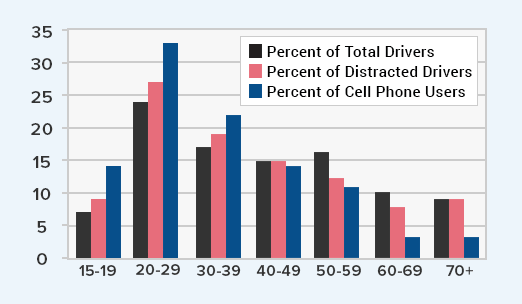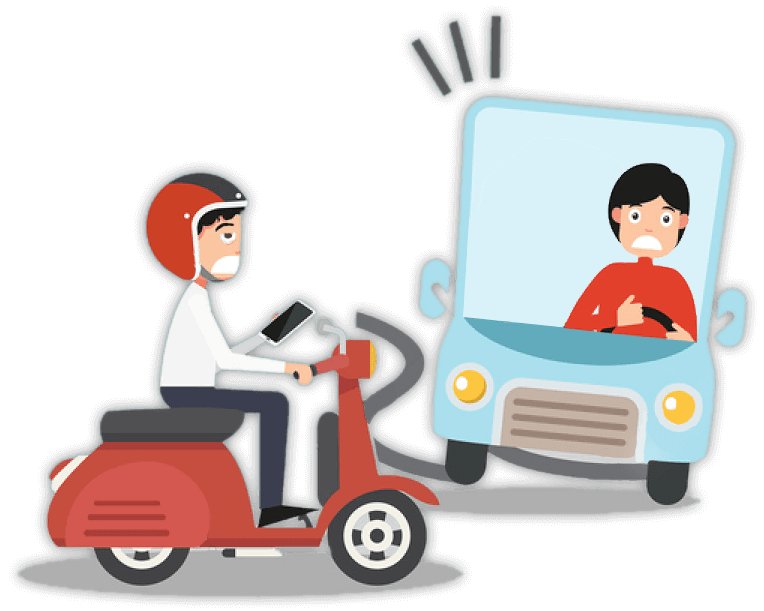Welcome to the most comprehensive resource on Distracted Driving available on the Internet. Whether you are researching Distracted Driving for a paper, want to make a point to an organization or are looking for data and resources, along with the current laws for all 50 states, now you only have to go to one place.
If you happen to get a ticket for distracted driving or are involved in an accident due to your distracted driving, then you may face higher car insurance premiums. However, the consequences of distracted driving are felt by each and every one of who carry insurance, due to higher rates overall. Ending distracted driving is a great way to make our roads safer and our insurance premiums lower.
Each day in the United States, approximately 9 people are killed and more than 1,000 injured in crashes that are reported to involve a distracted driver.
Distracted Driving

Distracted driving means the driver is doing something that takes their attention away from the road. There are three categories of distracted driving:
Cognitive distraction means you're paying attention to something other than driving.
Visual distraction occurs when you take your eyes off the road.
Manual distraction is when you remove your hands from the steering wheel.
It may sound like it isn't a big deal but the fact of the matter is that distracted driving accidents injure over 1,000 people every day in the U.S. and kills about nine more.
If you think this doesn't apply to you because you never text while driving, think again. Although texting is one of the biggest factors in distracted driving there are other simple things you may do each day that also fall into the one of the distracted driving categories. Here are some examples:
Talking to a passenger, trying to get the kids to stop arguing in the back seat, and smoking are all cognitive distractions.
Looking at your phone, GPS, or addresses are all visual distractions.
Grabbing a burger from the bag, changing the radio station, and drinking are all manual distractions.
Distracted Driving Laws

The laws against distracted driving vary depending on which state you're driving in. Nine states have comprehensive distracted driving laws in place, meaning the law covers any activity that is not related to the operation of the vehicle. All states except Arizona, Missouri, and Montana have laws that prohibit texting while driving, and all but eight states have laws that ban teens from cell phones while driving. Depending on where you're traveling various states bar hand held cell phones, a state preemption on cell phones, and school bus drivers using cell phones.
The penalties for distracted driving vary widely, too. In Alabama it is a $25 ticket and two points while if you're caught driving distracted in Alaska the fine is $10,000 and one year in prison. Most states charge distracted drivers between $100 and $500 for a distracted driving ticket.
Because there's such a high chance of being in an accident and a wide range of penalties your best bet is to get into the habit of never allowing yourself to be distracted when you're behind the wheel and learn the laws where you plan to be traveling. The following links detail the specific distracted driving laws for each state as well as the District of Columbia:
Alabama
Goal toward zero deaths in a 25-year period.
Alabama
Current legislation and determination of what constitutes distracted driving
Alaska
No limit on cell use but a hefty fine for texting and driving.
Arizona
No statewide ban, but teens cannot text and drive and Tucson passed a hands-free law.
Arkansas
As of 2017. no texting and driving, includes all hands-on usage of a phone while driving
California
No handheld use of a phone, except for a single swipe or tap. Anything more subject to fine.
Colorado
Colorado increased the penalty for texting and driving and drivers under 18 cannot use a phone and drive under any circumstance.
Connecticut
Link to all of Connecticut's laws and resources regarding distracted driving.
Delaware
Hands-free law is strict and they ban handheld cell use altogether along with a complete texting ban.
Florida
Texting while driving is illegal in Florida and they have a 'Put it Down' campaign to raise awareness of DD.
Georgia
Teens cannot use phones at all and there is a no-texting law in Georgia.
Hawaii
Since 2010, Hawaiian drivers cannot use a handheld device even at a stop sign or stoplight.
Idaho
Idaho has a ban on texting while driving.
Illinois
Illinois law prohibits the use of hand-held cellphones. Drivers 19 and over can use Bluetooth.
Indiana
Indiana drivers face fines of $500 for typing, transmitting or reading texts or emails.
Iowa
Starting in 2017, legislation got more specific and prohibited not just texts but all handheld use of phone while driving
Kansas
Currently, Kansas prohibits texting and driving, with more specific bills in the legislature right now.
Kentucky
Texting and driving is illegal for all drivers, and teen drivers cannot use the handheld device while the car is in motion.
Louisiana
Texting and driving is illegal, and all cell phone use in a school zone is also prohibited.
Maine
All handheld use is banned, and hands-free devices are allowed for everyone except young drivers.
Maryland
All handheld use is banned, from talking to texting to emailing. All fully licensed residents can use hands-free.
Massachusetts
Massachusetts bans texting and limits cell phone use while driving, and has new restrictions for older drivers.
Michigan
Michigan does not have any statewide restriction on using a cell phone while operating a vehicle.
Minnesota
If your device is permanently affixed to the dash, you can use it, but otherwise all use is banned.
Mississippi
Novice drivers are prohibited from texting and driving and they give tips to prevent distracted driving.
Missouri
Texting and driving is not allowed in Missouri and some cities do not allow any cell phone use.
Montana
Several cities have a ban on texting and driving, but a partial statewide ban has yet to pass.
Nebraska
Nebraska has an all-driver texting and driving ban.
Nevada
Texting, accessing the internet and hand-held cell phone use while driving are against the law in Nevada effective Oct. 1, 2011.
New Hampshire
New Hampshire prohibits texting and driving and all use of mobile electronic devices while driving.
New Jersey
Drivers in New Jersey cannot talk or listen to another person, or text using a handheld device.
New Mexico
All texting and driving is banned in New Mexico.
New York
All drivers cannot use mobile electronic devices for talking, texting, playing games unless hands-free or face license suspension plus fines.
North Carolina
Drivers cannot text or read emails while driving in North Carolina.
North Dakota
Text messaging is prohibited for all drivers, and all phone usage is prohibited for teen drivers.
Ohio
Ohio has a no texting while driving ban, and younger drivers cannot use their phones for any reason.
Oklahoma
Oklahoma has a texting and driving ban in effect since 2015, with $100 fine.
Oregon
Oregon has strict laws, saying you cannot even hold your phone while driving, even at a stoplight.
Pennsylvania
Drivers cannot send or receive texts while the car is in motion.
Rhode Island
Rhode Island has a law prohibiting texting and driving while the car is in motion.
South Carolina
You cannot use a wireless electronic device while driving in South Carolina.
South Dakota
South Dakota prohibits texting and driving as a secondary offense, with a $100 fine.
Tennessee
Texting and driving a vehicle in Tennesee is illegal.
Texas
Sending and receiving texts is illegal in Texas.
Utah
Drivers cannot use a handheld communication device while operating a motor vehicle.
Vermont
Vermont's laws prohibit use of handheld electronic devices while driving or stopped.
Virginia
Virginia does not allow texting or reading an email and driving, with no restrictions while stopped.
Washington
Washington's law goes beyond banning simply texting and includes anything that can interfere with operating a motor vehicle.
West Virginia
Handheld use is prohibited while operating a motor vehicle except when pulled over to the side of the road.
Wisconsin
Texting and driving is illegal for all drivers, while handheld and hands-free use is illegal for all junior drivers.
Wyoming
Officers can pull over and ticket anyone suspected of texting and driving in Wyoming.
District of Columbia
Prohibits use of handheld electronic devices while operating a motor vehicle.
Apps to Help Prevent Distracted Driving
Since texting has become such a vital part of today's communication system the cell phone industry is working hard to help you survive your road trip without getting distracted by your phone. Most major carriers have now developed apps that will silence your phone when you reach a specific speed; other apps are available that will turn text messages into voice and even read your emails out loud for you.
Here are some other features you can find on various safe driving apps; note that you'll still have to check for phone compatibility when choosing your apps:
Parental check in
Safe miles driven tracker
Safe driving rewards
Because texting and driving is one of the most common instances of distracted driving it is also the most dangerous bad driving habits for teens. The following links give you the apps available from the major phone carriers as well as other cell phone apps designed to teach and promote cell-free driving habits:
ATT
DriveMode app for iPhone and Android starts when car moves more than 15 mph and silences text alerts
Sprint
Android-only app sends calls right to voicemail and silences email and text alerts when car reaches 10mph.
Verizon
Driving Mode mutes incoming messages, you can set up auto-replies and whitelist certain contacts.
Focus
IPhone only app for training drivers to not use devices while driving, and parents can get a report of how the kids did.
SafeDrive
Drive, earn and play with this fun app that makes a game out of NOT being on your phone while driving.
MessageLOUD
MessageLOUD is available for both iOS and Android and it reads emails and texts out loud for you.
TxtBlocker
Allows parents to block texts from coming through to their kids' phones while they are on the road and set up no-cell zones to eliminate distractions.
Groove
Groove seeks to make distracted driving an unacceptable behavior by storing messages and calls in the cloud and only sending through once parked.
Organizations that Promote Distraction Free Driving
The National Highway Traffic Safety Administration (NHTSA) is the US government's official organization that promotes safe driving, and there are several more groups that advocate for the cause. The National Safety Council (NSC) and the American Automobile Association (AAA) promote learning seminars both in the workplace and in classrooms on a national level; the Governors Highway Safety Association (GHSA) encourages distracted driving prevention on the state level.
Perhaps the most effective promotion for instilling safe driving habits begins at the grassroots level. Many of these organizations have materials available for schools and businesses and will help local groups begin their own programs to educate both new and experienced drivers on the best practices to make safe and focused driving a lifelong habit.
The following links are for organizations that fight distracted driving:
NHTSA
The National Highway Traffic Safety Association is dedicated to making roads safer through information.
NSC
The National Safety Council explains their initiative on stopping distracted driving.
GHSA
Governors Highway Safety Association has a website detailing distracted driving news and laws.
IIHS
The Insurance Institute for Highway Safety has a wealth of information about distracted driving along with laws in every state.
CDC
Center for Disease Control and Prevention information about distracted driving in the U.S.
AAA
The American Automobile Association has a study on distracted driving among older adults.
UMTRI
University of Michigan Transportation Research Institute researches key transportation topics, among them distracted driving.
VTTI
The Virginia Tech Transportation Institute research publications on driver, passenger, pedestrian safety, vehicle design and infrastructure.
TSM
NHTSA communications resource for states, partner organizations, and highway safety professionals
NHTSA
Pedestrian and Bicycle Information Center gives data and resources on crash statistics and how to be safer on the road.
Travelers
The Every Second Matters initiative from Travelers Institute challenges drivers to set a positive example and eliminate distracted driving.
DDFN
Distracted Driving Foundation lobbies cell phone companies to create better display intensive use of phones while driving.
DIAD
Drop it and Drive is a Traffic Injury Research Foundation education program for preventing distraction-related road fatalities.
Loyola University
Loyola University Health System's Distracted Driving prevention tips
Teen Distracted Driving Prevention
Our current generation of teens is the first that uses texting as their main form of communication, making it vital to educate them about the dangers of both texting and reading texts while they are behind the wheel. According to the NHTSA nine percent of accidents involving teens aged 15 to 19 were because of distracted driving, and this age group has the largest share of fatal accidents caused by distraction. Although there are other types of distracted driving such as eating or conversing with a passenger the current raise in distracted driving fatalities is cell phone use, so it makes sense to put the focus of education on new drivers who use cell phones the most.

The most successful way to prevent teen distracted driving is to instill it as a habit when they are in the process of learning to drive. That is one of the main focal points for safe driving programs that are geared towards teens. The following sources are for teen distracted driving prevention and include resources for parents of teens as well.
Teen Drive 365
Teen driving resource sponsored by Toyota to encourage keeping teens safe behind the wheel.
EndDD
End Distracted Driving is an association created in honor of Casey Feldman and has resources for educators and parents to end DD.
Impact Teen Drivers
California non-profit committed to ending distracted driving among teen drivers.
PSDP
The Parent Supervised Driving Program seeks to help teens during the learner’s permit period through education.
CHOP
Teen Driver Source from the Children's Hospital of Philadelphia has resources for parents and educators.
Tips to Prevent Distracted Driving
While reading and sending text messages is the biggest culprit for distracted driving there are other habits you can identify and break in order to become a more focused driver. Here are some tips to help prevent distracted driving regardless of your age:
Plan ahead. Set your GPS, turn off your phone and any other electronics, and set your mind on your trip before you get on the road.
Make any needed adjustments to your mirrors, seat, heat or air conditioning, and any other vehicle systems before you put your car in gear.
Skip the food and drinks if at all possible; if you're on a long trip and have to eat stick to neat snacks instead of messy meals.
Make sure your kids and pets are secure before you leave. If you have to attend to them pull off the road first.
Do your personal grooming before you get into the car. If you have to brush your hair or remove your jacket pull over and park.
Stash any loose gear such as a handbag or briefcase before you leave the driveway. Check your vehicle for anything that might roll off a seat or console and secure it before you leave.
If you have passengers that tend to distract you feel free to politely tell them you need to focus on your driving.
Remember, anything that takes your attention from the role of driving is a distraction. It only takes a second to have an accident, so plan ahead and pay attention!
Effects of Distracted Driving: 10 Studies
- Research from AAA Foundation for Traffic Safety showing how in-vehicle technology can cause dangerous visual and mental distractions for drivers.(AAA)
- The correlation between using a cell phone while driving and the odds of being involved in a crash (AAA)
- Traffic safety facts concerning distracted driving and electronic devices (NHTSA)
- Distracted driving while at work (CDC)
- Research on distracted driving (2015 NHTSA)
- Distracted driving statistics (Travelers)
- The risks involved with distracted driving (AAA)
- Special Considerations in Distracted Driving with Teens (US National Library of Medicine National Institutes of Health (NIH))
- Legal Consequences of Distracted Driving (HG.org)
- A meta-analysis of the effects of texting on driving (Science Direct)
Distracted Driving FAQ
Other Resources for Distracted Driving Prevention

- The National Safety Council (NSC) promotes April as Distracted Driving Month to call attention to the hazards of distracted driving. Download a poster, fact sheet, infographics, and a number of social media-friendly graphics here
- The NSC also has a Safe Driving Kit to promote safe driving at the workplace and is perfect for human resource departments
- The Mechanical Contractors Association of America (MCAA) has several resources available, primarily for distracted driver prevention for drivers in the construction industries
- 4 Resources for Distracted Driving Awareness Month from Safe Start
